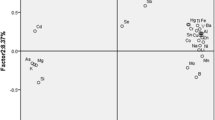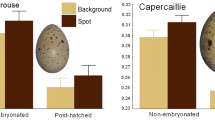Abstract
Despite substantial interest in the trace element content of eggs by poultry breeders, nutritionists, and environmental scientists, available data about trace elements levels in eggs are scarce. Trace element contents in yolk and albumen of chicken, turkey, duck, goose, and pigeon eggs were analyzed to establish a baseline dataset and assess differences among trace element content in avian species. We measured the selenium (Se), zinc (Zn), manganese (Mn), cobalt (Co), copper (Cu), molybdenum (Mo), vanadium (V), chromium (Cr), nickel (Ni), arsenic (As), cadmium (Cd), and thallium (Tl) contents in both yolk and albumen by inductively coupled plasma mass spectrometry. One hundred twenty eggs deriving from 24 birds of each species, reared in the same poultry farm in northern Greece, were used; bird feed was common and based on cereals and legumes and contained no added vitamins or microminerals. Trace element contents in yolks were far higher than those in albumen, except for V and Ni. In yolks, the highest content for Se, Mo, and Tl were in pigeon eggs, for Zn, Mn, Cu, and Cr in turkey eggs, and for Co and Ni in goose eggs. In albumen, Se was highest in duck eggs, while Zn, Mn, and Co in pigeon ones. It is concluded that there is a substantial, up to threefold, variation for trace element contents in eggs among different domestic avian species offered the same feed.
Similar content being viewed by others
References
Surai PF, Sparks NHC (2001) Designer eggs: from improvement of egg composition to functional food. Trends Fd Sci Tech 12:7–16
Surai PF (2002) Natural antioxidants in avian nutrition and reproduction. Nottingham University Press, Nottingham
Pappas AC, Karadas F, Surai PF, Wood NAR, Cassey P, Bortolotti GR, Speake BK (2006) Interspecies variation in yolk selenium concentrations among eggs of free-living birds: the effect of phylogeny. J Trace Elem Med Biol 20:155–160
Wilson JX, Lui EMK, Del RF (1992) Developmental profiles of antioxidants and trace elements in chick embryo. Mech Age Dev 65:51–64
Pappas AC, Karadas F, Surai PF, Speake BK (2005) The selenium intake of the female chicken influences the selenium status of her progeny. Comp Biochem Physiol B 142:465–474
Hoffman DJ, Heinz GH (1988) Embryotoxic and teratogenic effects of selenium in the diet of mallards. J Toxicol Environ Hlth 24:477–490
Harding LE, Graham M Paton D (2005) Accumulation of selenium and lack of severe effects on productivity of American dippers (Cinclus mexicanus) and spotted sandpipers (Actitis macularia). Arch Environ Contam Toxicol 48:414–423
Bryan AL, Hopkins WA, Baionno JA, Jackson BP (2003) Maternal transfer of contaminants to eggs in common grackles (Quiscalus quiscala) nesting on coal fly ash basins. Arch Environ Contam Toxicol 45:273–277
Burger J, Gochfeld M (1995) Heavy metal and selenium concentrations in eggs of herring gulls (Larus argentatus): temporal differences from 1989 to 1994. Arch Environ Contam Toxicol 29:192–197
Lam JCW, Tanabe S, Chan SKF, Lam MHW, Martin M, Lam PKS (2006) Levels of trace elements in green turtle eggs collected from Hong Kong: evidence of risks due to selenium and nickel. Environ Pol 144:790–801
Burger J, Gochfeld M (2004) Metal levels of common terns (Sterna hirundo) in New Jersey: temporal trends from 1971 to 2002. Environ Res 94:336–343
Burger J (1994) Heavy metals in avian egg shells: another excretion method. J Toxicol Envir Hlth 41:207–220
Date AR, Gray AL (1983) Development progress in plasma source mass spectrometry. Analyst 105(1283):159–165
National Research Council (1984) Nutrient requirements of poultry, 8th edn. National Academy Press, Washington, DC
Sparks NHC (2006) The hen’s egg—is its role in human nutrition changing? Worlds Poult Sci J 62:308–315
Surai PF, Speake BK, Wood NAR, Blount JD, Bortolotti GR, Sparks NHC (2001) Carotenoid discrimination by the avian embryo: a lesson from wild birds. Comp Biochem Physiol B 128:743–750
Speake BK, Surai PF, Noble RC, Beer JV, Wood NAR (1999) Differences in egg lipid and antioxidant composition between wild and captive pheasants and geese. Comp Biochem Physiol B 124:101–107
Surai PF, Bortolotti GR, Fidgett AL, Blount JD, Speake BK (2001) Effects of piscivory on the fatty acid profiles and antioxidants of avian yolk: studies on eggs of the gannet, skua, pelican and cormorant. J Zool Lond 255:305–312
Pappa EC, Pappas AC, Surai PF (2006) Selenium content in selected foods from the Greek market and estimation of daily intake. Sci Total Envir 372:100–110
Klapec T, Mandic ML, Grgic J, Primorac LG, Perl A, Krstanovic V (2004) Selenium in selected foods grown or purchased in eastern Croatia. Fd Chem 85:445–452
Simonoff M, Hamon C, Moretto P, Llabador Y, Simonoff G (1988) Selenium in foods in France. J Fd Compos Anal 1:295–302
Kadrabova J, Madaric A, Ginter E (1997) The selenium content of selected foods from the Slovak Republic. Fd Chem 58:29–32
Kirkpatrick DC, Coffin DE (1975) Trace metal content of chicken eggs. J Sci Fd Agric 26:99–103
Hieftje GM, Vickers GH (1989) Developments in plasma source/mass spectrometry. Anal Chim Acta 216:1–24
Ferguson EL, Gibson RS, Weaver JSD, Heywood P, Heywood A, Yaman C (1989) The mineral content of commonly consumed Malawian and Papua New Guinean foods. J Fd Comp Anal 2:260–272
Hui CA (2002) Concentrations of chromium, manganese, and lead in air and in avian eggs. Environ Pol 120:201–206
Khajali F, Khoshoei EA, Moghaddam ZAK (2006) Effect of vitamin and trace mineral withdrawal from finisher diets on growth performance and immunocompetence of broiler chickens. Brit Poult Sci 47:159–162
Surai PF, Papazyan TT, Speake BK, Sparks NHC (2007) Enrichment in selenium and other trace elements. In: Huopalahti R, López-Fandiño R, Anton M, Schade R (eds) Bioactive egg compounds. Springer, Berlin, pp 183–190
White HB (1991) Maternal diet, maternal proteins and egg quality. In: Deeming DC, Ferguson MWJ (eds) Egg incubation: its effects on embryonic development in birds and reptiles. Cambridge University Press, Cambridge, pp 1–15
Yneyama C, Toda M, Yamamoto M, Morikawa K (2007) Arsenic in various foods: cumulative data. Fd Add Contam 24(5):447–534
Van Overmeire I, Pussemier L, Hanot V, De Temmerman L, Hoenig M, Goeyens L (2006) Chemical contamination of free-range eggs from Belgium. Fd Add Contam 23(11):1109–1122
AOAC (1990) Official methods of analysis, 14th edn. Association of Official Analytical Chemists, Arlington
Acknowledgements
The authors would like to thank Messieurs Nikolaos and Anastasios Tsalkantis, owners of the poultry farm (Kotopoula Barbagianni, Gianitsa), for the supply of eggs and feed.
Author information
Authors and Affiliations
Corresponding author
Rights and permissions
About this article
Cite this article
Nisianakis, P., Giannenas, I., Gavriil, A. et al. Variation in Trace Element Contents Among Chicken, Turkey, Duck, Goose, and Pigeon Eggs Analyzed by Inductively Coupled Plasma Mass Spectrometry (ICP-MS). Biol Trace Elem Res 128, 62–71 (2009). https://doi.org/10.1007/s12011-008-8249-x
Received:
Accepted:
Published:
Issue Date:
DOI: https://doi.org/10.1007/s12011-008-8249-x




